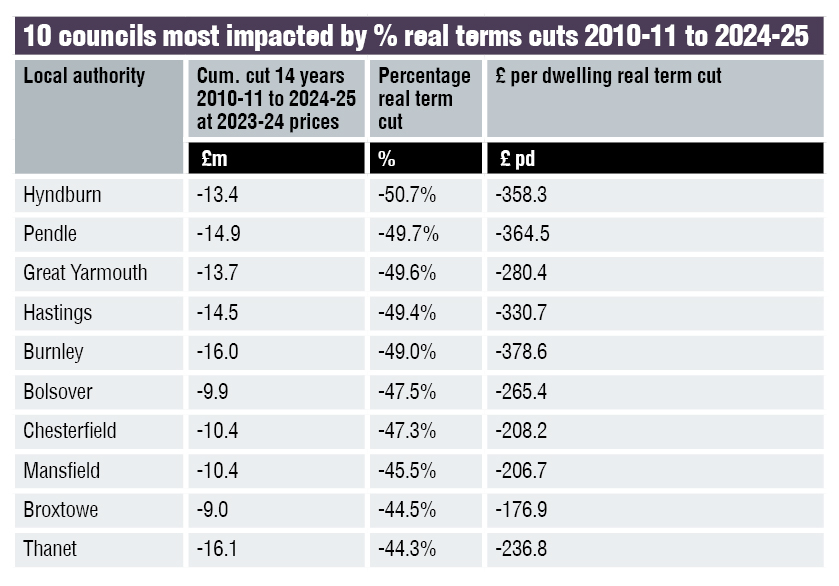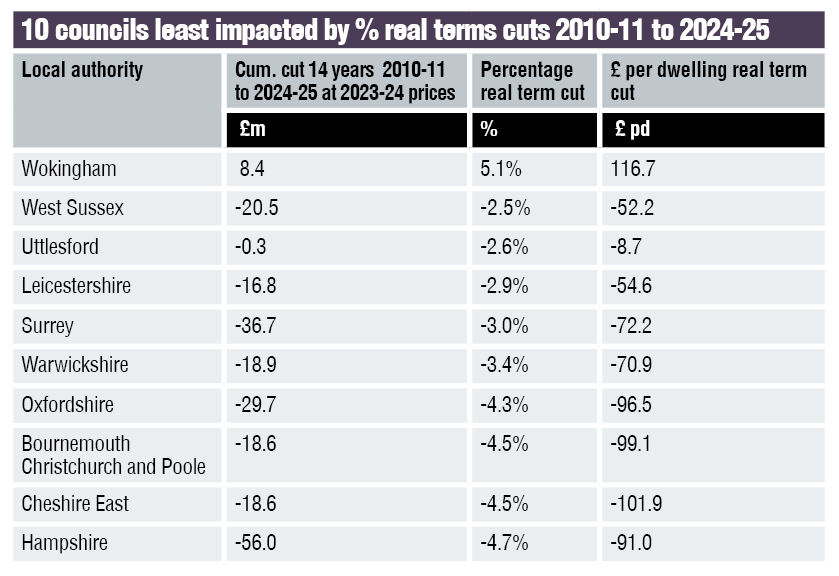The chancellor may be poised to deliver his Spring Budget, but local government is not eagerly anticipating much in the way of largesse.
Ministers are adamant councils clamouring for funding have already been listened to, pointing to the recent £600m extra cash injection in the final Local Government Finance settlement.
But, while this additional cash was welcomed by the sector, new analysis seen by The MJ has revealed just how far council funding has been cut since 2010-11.
The extra funding was broadly welcomed by councils. But new data from the Special Interest Group of Municipal Authorities (SIGOMA), obtained by The MJ, has delivered a stark overview of the sheer scale of the funding cuts to local government since 2010-11. It has also highlighted how the cumulative impact of spending reductions has hit the most deprived areas hardest.
SIGOMA suggests the analysis has shown core spending power in local government in England in 2024-25 is 18.1% lower than in 2010-11 in real terms – a drop of £13.9bn.
And it has revealed upper tier councils in the most deprived decile have seen the highest real terms cut in their core spending power of 26.6% since 2010-11. At a household level that is equivalent to a real terms reduction of £995 per dwelling. Those in the least deprived decile, by contrast, had a real terms cut in their spending power of 7%, a cut of £168 per dwelling.
According to SIGOMA's findings the 10 councils hit hardest since 2010-11 include Hyndburn BC, which saw a 50.7% cumulative real terms cut in funding, Pendle BC (49.7%), and Great Yarmouth BC (49.6%).

Cllr Carl Smith, leader of Great Yarmouth BC told The MJ: ‘These figures show the pressure on local authorities across the country.'
He said the council was continuing to lobby over its finance, including a call for a review of fair funding, business rates and council tax, as well as calling for multi-year settlements for increased certainty.
He added: ‘Great Yarmouth BC is penalised because of our low council tax base, which affects our new homes bonus. This means we have to deliver two properties where other neighbouring councils can deliver one to get the same benefit.'
Birmingham City Council issued a section 114 notice in September and will cut spending on services by £300m to balance its budget and increase council tax by 21% over the next two years. It has seen a 27.3% real terms reduction in funding since 2010-11, with a reduction in spending power per household of £1,082. Camden LBC's real terms cut is 30.1%, with a per dwelling cut of £1,309.
Other councils were hit less hard. The 10 councils impacted least by cuts since 2010-11 include Wokingham BC, the second least deprived upper tier authority in England.

Wokingham is the only council in England to experience a real terms increase – of 8.4% – in core spending power over the last 14 years and a per household real terms increase of £116.
While that may look like good news for Wokingham the council was the lowest grant funded unitary in 2010-11, so it is coming from a low base.
Council leader Stephen Conway explained the council still receives £48m a year less in government funding that it would if it was funded at the average.
He told The MJ: ‘Costs are escalating at up to 25% a year in areas of statutory care demand and even higher than 25% a year in the individual cost of care placements.
‘This issue is not about a simplistic view of league tables, however calculated, but more about a fundamental review of sustainable local dovernment finance that recognises the genuine costs councils face.'
Looking at the differential impact of the cumulative cuts on different council types, metropolitan authorities saw a 24% real terms cut in their spending power since 2010-11, the same scale of loss experienced by London boroughs. In contrast, the drop in funding shire counties was 7%.

But Clive Palfreyman, director of finance at Southwark LBC and Society of London Treasurers president, highlighted the cuts since 2010-11 have hit all types of councils.
He told The MJ: ‘While the data shows London has been hit hard by reductions in funding and demand increases, this is a sector-wide issue whereby all types of local government authorities should be working together and in partnership with central government bodies to strategically plan a path through those challenges in order to successfully deliver for our local communities.'
He added: ‘A financial settlement for a longer period than a single year would be a helpful platform from which to base those discussions.'
Cllr Elizabeth Dennis, finance spokesperson at the District Councils' Network, called the SIGOMA data ‘helpful'. She told The MJ: ‘District councils absolutely understand the importance of social care and the impact other sorts of councils have been experiencing on their budget lines.
‘But a lot of the extra funding central government has been shouting about hasn't actually trickled down to district council level. It's gone to the county councils, to the metropolitan boroughs, so districts have very much been the poor relation when it comes down to local government funding.'
The County Councils' Network was also approached for comment.
A spokesperson for the Department for Levelling Up, Housing and Communities said: ‘The final Local Government Finance Settlement for 2024-25 has made up to £64.7bn available, an increase in core spending power of up to 7.5% in cash terms on 2023-24.
‘We continue to monitor pressures on all councils, and we stand ready to talk to any council that is concerned about its financial position.'
What impact has the decline in local government's core spending power had at a local level? Writing about the data in this issue, chair of SIGOMA Cllr Sir Stephen Houghton said the cuts imposed since 2010 have meant ‘services people rely on…. have been reduced or scrapped while staff have been made redundant'. Among a host of calls for change, he hammered home his view that the Government must get cracking with the proposed – then closed – fair funding review.
Cries for a radical reworking of local government funding are reaching a crescendo. In a separate article this issue, Kevin Muldoon-Smith and Mark Sandford argued the fair funding review should be ‘reopened and delivered, paving the way for yearly needs assessments and longer-term funding settlements'.
But the waiting game continues as the sector waits to see just how much of a priority an incoming government will give to putting council finances on a more secure and sustainable footing.
A full analysis of changes in local government core spending power at local authority level since 2010-11 is available here

